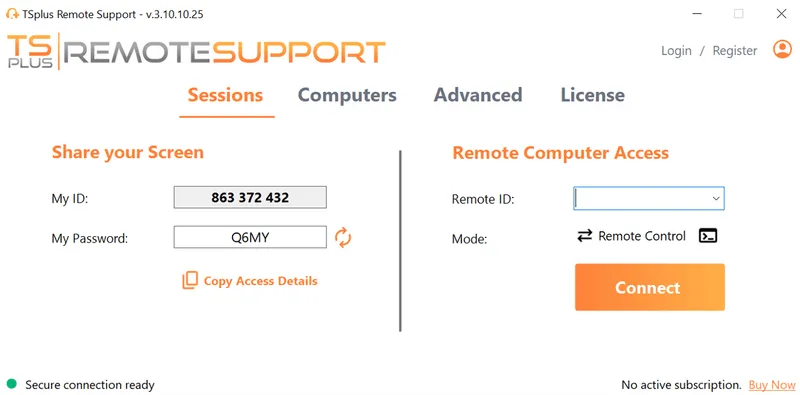)
)
What Is Remote Screen Control Software?
Remote screen control software refers to applications that enable one computer (client) to view and control another computer (host) remotely over a network. These tools form the backbone of remote IT support, enabling real-time interaction with a distant system’s graphical interface.
Definition and Capabilities
Remote screen control goes beyond passive screen sharing. It provides the ability to:
- Simulate local input (keyboard and mouse) on the host machine
- View the host desktop in real time
- Transfer files between devices
- Run background or elevated operations (with appropriate privileges)
- Restart and reconnect to machines even after reboot
This makes it an indispensable tool for IT teams providing remote support, enabling them to control a user’s device in real time to diagnose and resolve issues.
Differentiating from Related Technologies
Remote screen control is often grouped with or confused for:
- Remote desktop (like RDP or VNC): Typically involves logging into a remote system with a full session
- Screen sharing: Visual-only, often used in conferencing, without control
- Remote monitoring: Tools that track performance or behavior but don’t enable active control
Remote screen control tools combine elements of each but focus specifically on real-time, bi-directional interaction.
Use Contexts
This class of software is widely used for:
- Remote support and helpdesk services
- Remote administration and patching
- End-user training and shadowing
- Collaboration across distributed teams
How Does Remote Screen Control Software Work?
The power of remote control software lies in its architecture. At a high level, it relies on a set of protocols, networking techniques, and system hooks to establish, maintain, and secure remote sessions.
Client-Server Model
Remote control software typically follows a client-server model:
- Host: The server-side application runs on the machine being controlled. It captures screen frames, system state, and accepts remote input.
- Client: The viewer or controller interface that allows the remote operator to interact with the host.
Depending on the architecture, the connection may be direct (peer-to-peer) or mediated through a relay server. In remote support scenarios, this architecture allows a technician to initiate a secure session with an end-user’s device, ensuring efficient intervention without physical presence.
Screen Capture and Input Injection
- The host agent captures framebuffer or GUI-level screen data using APIs like GDI, DirectX, or platform-specific capture hooks.
- This screen stream is compressed (e.g., with H.264, VP8) and transmitted in real time to the client.
- Input events (mouse, keyboard) are sent back from the client and injected using OS-level interfaces (like SendInput on Windows or uinput on Linux).
Networking and Traversal
Remote access requires NAT traversal and firewall negotiation:
- Direct connection via IP when both machines are on the same network or have port forwarding
- Relay/TURN servers for public internet access or when NAT/firewalls block direct routes
- UDP hole punching or STUN protocols are used for peer discovery in some advanced solutions
Session reliability is maintained via:
- Persistent TCP/UDP connections
- Keep-alive packets
- Automatic reconnection on link loss
Security and Authentication
- TLS/SSL encryption secures traffic from eavesdropping
- Session authentication via one-time codes, multi-factor auth, or directory services (e.g., LDAP, AD)
- Access controls define what the remote user can or cannot do (view-only, full control, clipboard access, etc.)
What Are The Core Features of Remote Screen Control Software?
The effectiveness of any remote control tool depends on the breadth and depth of its capabilities. For IT professionals, certain features are mission-critical.
Cross-Platform Compatibility
Professional environments often include a mix of Windows, Linux, macOS, and mobile devices. Top-tier solutions provide:
- Native or web-based clients across platforms
- Support for headless systems (servers without GUI)
- Mobile app support for on-the-go access
Unattended Access and Wake-on-LAN
Ideal for system maintenance:
- Unattended mode with persistent agent on host
- Secure credential vaulting for saved logins
- Wake-on-LAN functionality to power systems remotely
Multi-Session Support and Technician Management
- Support for concurrent sessions across multiple hosts
- Role-based access control (RBAC) for technician permissions
- Session handoff and collaboration features for team troubleshooting
For teams delivering remote support at scale, the ability to handle multiple concurrent sessions and assign roles is critical to maintain workflow efficiency.
File and Clipboard Transfer
- Encrypted file sharing during active sessions
- Clipboard synchronization between local and remote systems
- Optional drag-and-drop UI for ease-of-use
Session Logging and Recording
Critical for security and compliance:
- Full activity logs with timestamps and IPs
- Session video recording (compressed formats for archiving)
- Exportable reports for auditing and review
Bandwidth Optimization and Performance
- Adaptive encoding (adjust quality based on network conditions)
- Efficient protocols like RDP, proprietary UDP-based solutions, or optimized VNC derivatives
- Caching and delta updates to reduce screen redraw overhead
What Are The Use Cases for Remote Screen Control in IT Environments?
Remote screen control is a versatile tool. In professional settings, it’s used across departments and industries to streamline workflows, minimize downtime, and empower distributed teams.
Helpdesk and Remote IT Support
Remote access enables support staff to:
- Resolve end-user issues without physical presence
- Perform diagnostics and configuration changes
- Escalate and transfer sessions across support tiers
- Reduce MTTR (mean time to resolution)
Modern helpdesks rely on remote support tools to deliver timely assistance across geographies, reducing time-to-resolution and improving user satisfaction.
Remote Infrastructure Management
IT admins use screen control to:
- Access servers, routers, and headless systems
- Perform updates, reboots, and maintenance
- Monitor critical systems and intervene in real time
Security and Compliance Operations
Used for:
- Monitoring secure environments during audits
- Providing access to consultants under strict supervision
- Logging activity for regulatory compliance
Remote Work Enablement
With hybrid and remote teams:
- Technicians can support remote employees regardless of location
- Admins can provision new systems or troubleshoot VPN/connectivity issues
- Remote training or onboarding becomes interactive and efficient
What Are The Security Considerations for Remote Screen Control?
Security is non-negotiable when it comes to remote access. Improperly configured or insecure tools can introduce significant risk.
Encryption and Data Protection
- End-to-end encryption using TLS 1.2+ or AES-256 ensures confidentiality
- Optional self-hosted relay servers for organizations with strict data sovereignty requirements
- Disk encryption for session recordings and local logs
Authentication and Access Controls
- Role-based access with fine-grained policies
- SSO integration (SAML, OAuth, LDAP, AD)
- Two-factor or multi-factor authentication enforcement
- IP whitelisting and geofencing
Secure remote support demands strict user authentication and well-defined access control policies to prevent misuse and protect sensitive systems.
Auditability and Logging
- Immutable logs for forensic analysis
- Alerts on unauthorized access attempts
- SIEM integration for central log monitoring
System Hardening
- Minimal attack surface via signed binaries and hardened agents
- Auto-updates to patch vulnerabilities
- Support for FIPS-compliant crypto libraries
How Can You Choose the Right Remote Screen Control Software?
With so many vendors on the market, selecting the right solution requires matching capabilities with specific business and operational needs.
Licensing and Cost Structure
- Per-seat, per-technician, or per-session pricing
- Subscription vs. perpetual licenses
- Scalability for future growth
Ease of Deployment and Use
- No-VPN-required solutions reduce friction
- Lightweight agents and silent install options
- Intuitive interfaces for both IT and non-technical users
An ideal remote support solution should deploy quickly, minimize user interaction, and provide a seamless experience for both technicians and end-users.
Network Performance and Reliability
- High-performance under low-bandwidth conditions
- Global relay infrastructure or local server deployment
- Session auto-resume on drop
Vendor Support and Customization
- SLA-backed support
- White-label or branding options for MSPs
- API availability for integration with ITSM or RMM platforms
TSplus Remote Support: A Trusted Remote Screen Control Solution
TSplus Remote Support is a powerful and affordable remote screen control solution designed specifically for IT professionals and support teams. It provides secure, real-time remote access with end-to-end encryption, unattended session capabilities, session collaboration, file transfer, and technician chat—all without requiring complex network configurations or high subscription costs. With the option to self-host for full data sovereignty, the solution from TSplus offers a lightweight, efficient alternative to traditional SaaS tools, making it ideal for businesses and managed service providers seeking a scalable, private, and cost-effective way to deliver remote IT assistance.
Conclusion
Remote screen control software is a vital component of modern IT operations, enabling secure, real-time access to systems across the globe for support, administration, and collaboration. Understanding the underlying technology, essential features, and security best practices allows IT professionals to make informed decisions and implement robust remote access strategies. With the right tool, organizations can streamline remote assistance, enhance operational agility, and maintain full control over access and data privacy, all while optimizing their IT support infrastructure.

TSplus Remote Support Free Trial
Cost-effective Attended and Unattended Remote Assistance from/to macOS and Windows PCs.














)
)
)